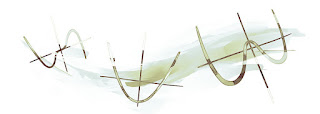To take just one example, a basic question about a number is whether it has a repeated prime factor. The number 12 does: It factors into 2 × 2 × 3, with the 2 occurring twice. The number 15 does not (it factors into 3 × 5). In general, there’s no quick way of knowing whether a number has a repeated factor. But there is an analogous geometric problem which is much easier.
Polynomials have many of the same properties as numbers: You can add, subtract, multiply and divide them. There’s even a notion of what it means for a polynomial to be “prime.” But unlike numbers, polynomials have a clear geometric guise. You can graph their solutions and study the graphs to gain insights about them. For instance, if the graph is tangent to the x-axis at any point, you can deduce that the polynomial has a repeated factor (indicated at exactly the point of tangency). It’s just one example of how a murky arithmetic question acquires a visual meaning once converted into its analogue for polynomials.
“You can graph polynomials. You can’t graph a number. And when you graph a [polynomial] it gives you ideas,” said Conrad. “With a number you just have the number.” The “geometric” Langlands program, as it came to be called, aimed to find geometric objects with properties that could stand in for the Galois groups and automorphic forms in Langlands’ conjectures.
The new work from Scholze and Fargues, however, finally fulfills the hopes pinned on the geometric Langlands program — by finding the first shape whose properties communicate directly with Langlands’ original concerns.
Scholze’s theory was based on special number systems called the p-adics. The “p” in p-adic stands for “prime,” as in prime numbers. For each prime, there is a unique p-adic number system: the 2-adics, the 3-adics, the 5-adics and so on. P-adic numbers have been a central tool in mathematics for over a century. They’re useful as more manageable number systems in which to investigate questions that occur back in the rational numbers (numbers that can be written as a ratio of positive or negative whole numbers), which are unwieldy by comparison.
The virtue of p-adic numbers is that they’re each based on just one single prime. This makes them more straightforward, with more obvious structure, than the rationals, which have an infinitude of primes with no obvious pattern among them. Mathematicians often try to understand basic questions about numbers in the p-adics first, and then take those lessons back to their investigation of the rationals. “The p-adic numbers are a small window into the rational numbers,” said Kaletha.
All number systems have a geometric form — the real numbers, for instance, take the form of a line. Scholze’s perfectoid spaces gave a new and more useful geometric form to the p-adic numbers. This enhanced geometry made the p-adics, as seen through his perfectoid spaces, an even more effective way to probe basic number-theoretic phenomena, like questions about the solutions of polynomial equations. “He reimagined the p-adic world and made it into geometry,” said Ben-Zvi.
In his Berkeley course, Scholze presented a more general version of his theory of perfectoid spaces, built on even newer objects he’d devised called diamonds. The theory promised to further enlarge the uses of the p-adic numbers. Yet at the time Scholze began teaching, he had not even finished working it out.
Fargues was attending a special semester at the Mathematical Sciences Research Institute. He had thought a lot about the p-adic numbers, too. For the past decade he’d worked with Jean-Marc Fontaine in an area of math called p-adic Hodge theory, which focuses on basic arithmetic questions about these numbers. During that time, he and Fontaine had come up with a new geometric object of their own. It was a curve — the Fargues-Fontaine curve — whose points each represented a version of an important object called a p-adic ring.
But as Fargues sat listening to Scholze, he envisioned an even greater role for the curve in mathematics. The never-realized goal of the geometric Langlands program was to find a geometric object that encoded answers to questions in number theory. Fargues perceived how his curve, merged with Scholze’s p-adic geometry, could serve exactly that role.
Fargues’ strategy came to be known as the “geometrization of the local Langlands correspondence.” But at the time he made it, existing mathematics didn’t have the tools he needed to carry it out, and new geometric theories don’t come along every day. Luckily, history was on his side.
Specifically, they came up with two different kinds: Coherent sheaves correspond to representations of p-adic groups, and étale sheaves to representations of Galois groups. In their new paper, Fargues and Scholze prove that there’s always a way to match a coherent sheaf with an étale sheaf, and as a result there’s always a way to match a representation of a p-adic group with a representation of a Galois group. In this way, they finally proved one direction of the local Langlands correspondence. But the other direction remains an open question. “It gives you one direction, how to go from a representation of a p-adic group to a representation of a Galois group, but doesn’t tell you how to go back,” said Scholze. The work is one of the biggest advances so far on the Langlands program.




